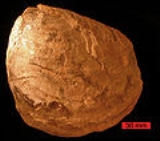
Inoceramus
Encyclopedia
Inoceramus is an extinct genus
of fossil marine
pteriomorphian bivalves that superficially resembled the related winged pearly oysters of the extant genus Pteria
.
The species of Inoceramus enjoyed a worldwide distribution during the Cretaceous
period. Many examples are found in the Pierre Shale
of the Western Interior Seaway
in North America. Inoceramus can also be found abundantly in the Cretaceous Gault Clay
that underlies London
. Other locations for this fossil include Vancouver Island, British Columbia, Canada; Texas, Tennessee, California and Alaska, USA; Spain, France, and Germany.
The clam had a thick shell paved with "prisms" of calcite
deposited perpendicular to the surface, which gave it a pearly luster in life. Most species have prominent growth lines which appear as raised semicircles concentric to the growing edge of the shell. Paleontologists suggest that the giant size of some species was an adaptation for life in the murky bottom waters, with a correspondingly large gill area that would have allowed the animal to cope with oxygen-deficient waters.
The number of valid species is disputed. The taxonomy
of the inoceramids is also disputed, with genera such as Platyceramus
sometimes classified as subgenus
within Inoceramus.
Genus
In biology, a genus is a low-level taxonomic rank used in the biological classification of living and fossil organisms, which is an example of definition by genus and differentia...
of fossil marine
Marine (ocean)
Marine is an umbrella term. As an adjective it is usually applicable to things relating to the sea or ocean, such as marine biology, marine ecology and marine geology...
pteriomorphian bivalves that superficially resembled the related winged pearly oysters of the extant genus Pteria
Pteria
Pteria may refer to:*Pteria a town in ancient Cappadocia * Pteria a genus of bivalve molluscs, the winged oysters...
.
The species of Inoceramus enjoyed a worldwide distribution during the Cretaceous
Cretaceous
The Cretaceous , derived from the Latin "creta" , usually abbreviated K for its German translation Kreide , is a geologic period and system from circa to million years ago. In the geologic timescale, the Cretaceous follows the Jurassic period and is followed by the Paleogene period of the...
period. Many examples are found in the Pierre Shale
Pierre Shale
The Pierre Shale is a geologic formation or series in the Upper Cretaceous which occurs east of the Rocky Mountains in the Great Plains, from North Dakota to New Mexico....
of the Western Interior Seaway
Western Interior Seaway
The Western Interior Seaway, also called the Cretaceous Seaway, the Niobraran Sea, and the North American Inland Sea, was a huge inland sea that split the continent of North America into two halves, Laramidia and Appalachia, during most of the mid- and late-Cretaceous Period...
in North America. Inoceramus can also be found abundantly in the Cretaceous Gault Clay
Gault Clay
Gault is a clay formation of stiff blue clay deposited in a calm, fairly deep water marine environment during the Lower Cretaceous Period...
that underlies London
Geology of London
The geology of London comprises various differing layers of sedimentary rock upon which London, England is built.-Oldest rocks:The oldest rocks proved through boreholes to exist below London are the old, hard rocks of the Palaeozoic. These consist of Silurian mudstones and sandstones, generally...
. Other locations for this fossil include Vancouver Island, British Columbia, Canada; Texas, Tennessee, California and Alaska, USA; Spain, France, and Germany.
The clam had a thick shell paved with "prisms" of calcite
Calcite
Calcite is a carbonate mineral and the most stable polymorph of calcium carbonate . The other polymorphs are the minerals aragonite and vaterite. Aragonite will change to calcite at 380-470°C, and vaterite is even less stable.-Properties:...
deposited perpendicular to the surface, which gave it a pearly luster in life. Most species have prominent growth lines which appear as raised semicircles concentric to the growing edge of the shell. Paleontologists suggest that the giant size of some species was an adaptation for life in the murky bottom waters, with a correspondingly large gill area that would have allowed the animal to cope with oxygen-deficient waters.
The number of valid species is disputed. The taxonomy
Taxonomy
Taxonomy is the science of identifying and naming species, and arranging them into a classification. The field of taxonomy, sometimes referred to as "biological taxonomy", revolves around the description and use of taxonomic units, known as taxa...
of the inoceramids is also disputed, with genera such as Platyceramus
Platyceramus
Platyceramus was a genus of Cretaceous bivalve molluscs belonging to the extinct inoceramid lineage. It is sometimes classified as a subgenus of Inoceramus.The largest and best known species is P. platinus...
sometimes classified as subgenus
Subgenus
In biology, a subgenus is a taxonomic rank directly below genus.In zoology, a subgeneric name can be used independently or included in a species name, in parentheses, placed between the generic name and the specific epithet: e.g. the Tiger Cowry of the Indo-Pacific, Cypraea tigris Linnaeus, which...
within Inoceramus.
External links
- The Paleontology portal fossil picture of Inoceramus
- cretaceousfossils.com: Inoceramus dimidius
- cretaceousfossils.com: Inoceramus perplexus
- Upper Cretaceous Bivalvia of Alabama

